In Part One, I explained that my husband and I travelled to Moelfre, not far from Oswestry, to see a sculptor by the name of Tony Meadows. During that visit, Tony had made an alginate and plaster mould to create a plaster of Paris and acrylic resin (Jesmonite) cast of our linked hands, an original piece of art we had commissioned to celebrate our 10th wedding anniversary.
Once cast, so that our sculpture had time to set to its final hardness, and for Tony to tidy up any imperfections, we would have to wait a week or two. We agreed a date to return to pick up the finished sculpture but life, as it so often does, got in the way so we weren’t able go back on the arranged day. A little disappointing, but no real problem.
The next date we would be able to make it to Moelfre was at the end of a holiday in Wales. We were going away with my sister and brother-in-law, and we’d booked this break to celebrate our birthdays and anniversary. This seemed the perfect opportunity as it meant our journey to see Tony to collect the hands would be much reduced.
However, before I tell you more about the exciting events of pick-up day, I thought I’d tell you more about an area of Wales we know and love. Think of it as a ‘Postcard from Ceredigion’.
This holiday was a particularly special one, not just because of the celebrations, nor because of the great company we would have. We were returning to stay in a delightful Victorian cottage next to its own pond, nestled in an absolutely stunning 18th century ‘Picturesque landscape’, the Hafod Estate in Wales. Quiet, secluded and utterly peaceful, without a television in sight, the only access to the cottage is down a rather narrow and windy forest track, then down some rather precipitous steps. The last time we’d stayed here, five years before, it started snowing on our last night and we really hoped we’d be snowed in. No such luck, sadly there was only a dusting.
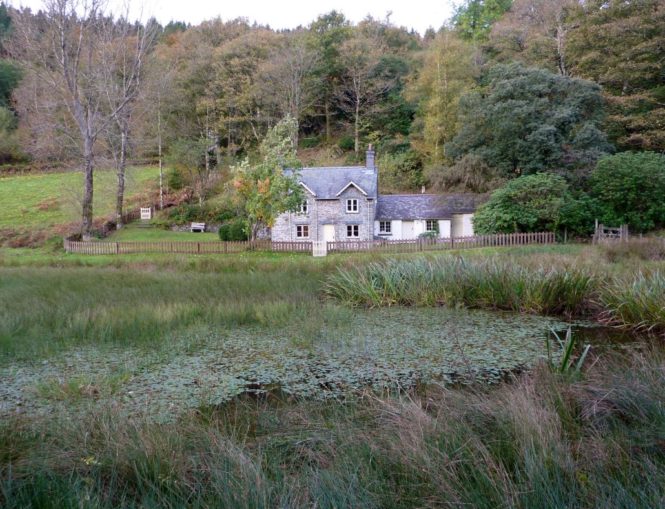
© SharpieType301 2013
The Hafod Estate sits in the Ystwyth Valley near Devil’s Bridge, in Ceredigion and, although now much reduced in size, it covers nearly 500 acres of woodland, wonderful waterfalls (for once, the abundant rainfall in Wales is a blessing) and miles of well-signed walks of varying length and level of difficulty. There are rustic bridges over ravines and rivulets, attractive ‘alpine’ aspects, caverns and grottoes, romantic ruins and riverbank rambles.
There’s considerably more to the Hafod Estate than simply the glorious landscape we see today though. At least as far back as the ‘golden age’ of the Elizabethan era, there was a substantial sized abode here; the area is renowned for mineral deposits, with silver, lead and zinc all mined here. As we will see, its zenith came with a major transformation in the 18th century by an extraordinary man, Thomas Johnes.
The concept of the Picturesque was developed by 18th century English artist, schoolmaster, author, and Anglican cleric, Reverend William Gilpin, who defined it as ‘that peculiar kind of beauty which is agreeable in a picture’. Picturesque could be wild natural beauty, imagine the shapes, colours and textures of a rugged mountain landscape, or man-made. Some 18th century landowners employed men such as Lancelot ‘Capability’ Brown and others to landscape their estates to ‘improve’ the outlook to fit this popular aesthetic.
The Hafod Estate is exceptional, and is recognised as one of the most important Picturesque landscapes of the late 18th century in Europe. It was a little different to many in that, rather than contracting one of the ‘names’ of the Picturesque landscaping world of that period, Thomas Johnes, who inherited the estate from his father in 1780, designed the layout, plantations and gardens at Hafod himself.
The land was quite a challenge, as the estate sits in a high-rainfall (up to 60” per year) area of upland, with some parts of the estate lying above 1,200 feet. Much of the land is high, steep and stony and the soils range from a shallow loam over slaty rock, to peaty bogs. To add to the fun, the estate’s higher ground was polluted and denuded of trees because of the important non-ferrous metal mining, which has been carried out since the Iron Age in the Ystwyth Valley. Traces are still visible around nearby Cwmystwyth. A poor inheritance? At first glance, perhaps, but not for a man of Johnes’ determination and abilities.
As well as building the obligatory but, sadly, no longer standing, Gothic mansion (Hafod House) to replace the previous house, Johnes was an innovator, visionary and benefactor. He cared deeply for the welfare of his tenants as well as his land, building a church and a school for them, and relocating many from decrepit housing to newly built cottages and providing them with secure employment on the estate. He established an experimental model farm, breeding sheep and cattle and growing new crops (proving many doubting ‘experts’ utterly wrong in the process – good man!). Perhaps his finest legacy is that he pioneered upland forestation in Wales.
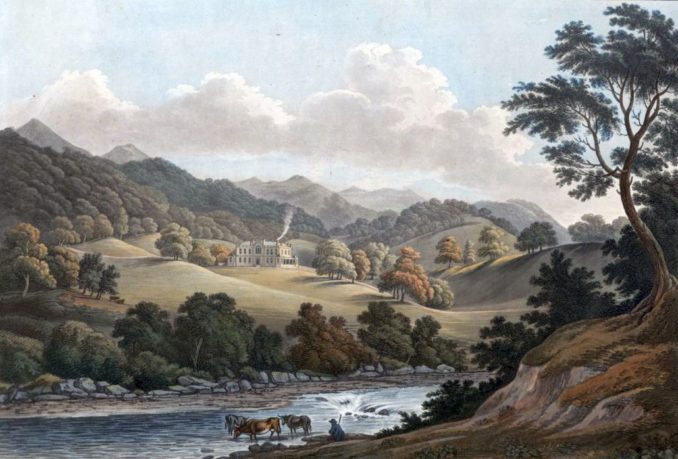
© Joseph Constantine Stadler (engraver), John Smith (artist)
CC0 1.0 Universal Public Domain Dedication
Elected a Fellow of The Royal Society, Johnes was awarded the Royal Society of Arts medal five times for silviculture. He planted over three million trees across the estate, mainly Oak (Quercus robur) and Beech (Fagus sylvatica) on the fertile lower land, with European Larch (Larix decidua) and some Scots Pine (Pinus sylvestris) on the supposedly barren high ground.
Other tree species planted included Norway Spruce (Picea albies), Ash (Fraxinus excelsior), Birch (Betula pendula), Wych Elm (Ulmus glabra), Alder (Alnus glutinosa), Black Poplar (Populus nigra), Holly (Ilex aquifolium), Spanish or Sweet Chestnut (Castanea sativa), Sycamore (Acer pseudoplatanus), and, of course, the lovely Rowan or Mountain Ash (Sorbus aucuparia), commonly planted outside Welsh homes to ward off evil spirits and witches’ spells.
Because the Hafod Estate was developed to be an exemplar of British landscapes in the Picturesque style, it attracted a great many visitors. Many of these early ‘tourists’ wrote about their marvellous experiences. The Welsh poet and lawyer, Richard Fenton, described Hafod as ‘a secret haunt … accessible to none but to the highly honoured few. ’ He wrote a poem about it in 1787.
The Genius of Hafod
Formal staves of art, avaunt!
This is Nature’s secret haunt:
The Genius of the Landscape, I
Guard it, with a jealous eye—
Guard it, that no footstep rude
Upon her privacy intrude.
Here, with mystic maze, her throne
Is girt, accessible to none
But to the highly-honour’d few
To whom I deign to lend my clue;
And, chief, to him who, in this grove,
Devotes his life to share her love;
From whom she seeks no charms to hide—
For whom she throws her veil aside,
Instructing him to spread abroad
Scenes for Salvator—or for Claude.
Far, oh far hence, let Brown and Eames
Zig-zag their walks, and torture streams!
But let them not my dells profane,
Or violate my Naiad train;
Nor let their arrogance invade
My meanest Dryad’s secret shade,
And with fantastic knots disgrace
The Native honours of the place—
Making the vet’ran oak give way,
Some spruce exotic to display:
Their petty labours be defy’d,
Who Taste and Nature would divide!
But back to our holiday there.
We arrived in the middle of October in torrential rain, and my sister and her husband joined us a couple of days later in… torrential rain! We had warned them though, so all of us were well prepared for walking in wet weather.
On our first day together, we set out to follow the circular ‘Lady’s Walk’ of about two miles. We only expected to be out for an hour at most, but were quickly sidetracked by the beautiful, rushing cascades and waterfalls (all that rain did us a good service, especially when we crossed the Chain Bridge over the little, narrow gorge), the dripping trees just beginning to turn to their autumnal glory.
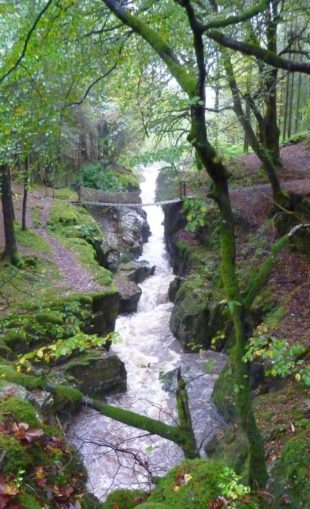
© SharpieType301 2013
We got back some five hours later, soggy and knackered but absolutely delighted. We’d stopped to drink cool, fresh water from the hillside springs and nibbled the late blackberries we found along the way, but a glass of single malt and a little snack of cheese and olives was extremely welcome. It revived us enough to cook a good Welsh lamb dinner. A nice robust red wine went rather well with it too, so it wasn’t a late night. It was another wet night though, but the sound on the cottage roof was quite comforting.
Multiple cups of tea in the morning gave enough time for the skies to clear, so we decided we’d risk it and tackle the Gentleman’s Walk, a rather more strenuous four miles over steep ground, through wild and wonderful scenery. One reason for this plan was that we expected the rivulets and falls, particularly the Cavern Cascade, to be pretty spectacular after all the rain that had fallen. The Cavern Cascade is an 18th century grotto designed by Thomas Johnes in 1795 as the final destination of his ‘Gentleman’s Walk’. Since 1998, it has been listed as a scheduled monument.
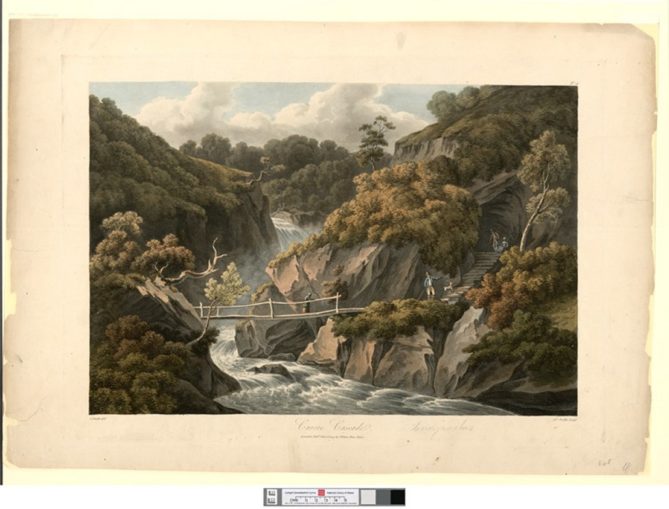
© Joseph Constantine Stadler (engraver), John Smith (artist)
CC0 1.0 Universal Public Domain Dedication
And so it proved, once we’d headed off down the Mansion Fields and crossed the River Ystwyth on the Alpine Bridge. The river is broad here and you can really see the tea-like colour of its peaty depths. The Gentleman’s Walk starts properly with a pathway across a rustic ‘Billy Goat Gruff’ wooden bridge, seen here from our first visit, with a delicate icing of snow.

© SharpieType301 2008
Then upwards through stands of tall, straight conifers, their springy needles underfoot softening all sound to a cathedral calm. We soon begin to hear water again, and the Mossy Seat Falls are revealed, with the rain-swollen stream tumbling down the stepped hillside in a series of torrents and falls, into backwaters and pools. The name is very appropriate, and the falls are lovely.
Onwards and up the path, which hugs the steep hillside with a significant drop-off to our left. Not for the faint-hearted, this route, especially when the stony paths are wet and slippery. But there’s a treat in store to take your mind off the precipitous perils as the path leads through the spooky darkness of the Allt Dihanog tunnel, cut through the rock bluff.
Back into the light once again, to see down onto the treetops, and the sunlight catching the river twisting and bending far below. There are massive beech trees, with cushions of viridian moss over almost every surface—even the tree trunks wear their own pull-up stockings of mossy green, and ferns abound.
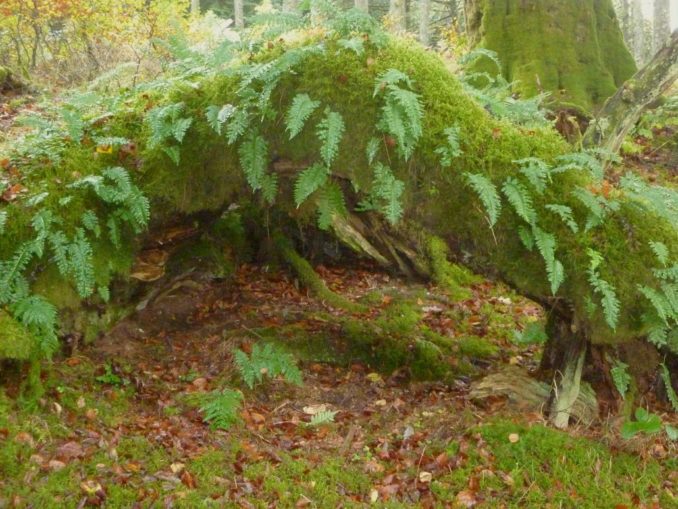
© SharpieType301 2013
Then there are the masses of different lichens and fungi, almost everywhere you look. Fly Agaric, Green Wood Cup (though they looked blue to me), Porcelain Mushrooms, Yellow Stagshorn, Coral Mushrooms, and many more. Simply fantastic, a fairy world.
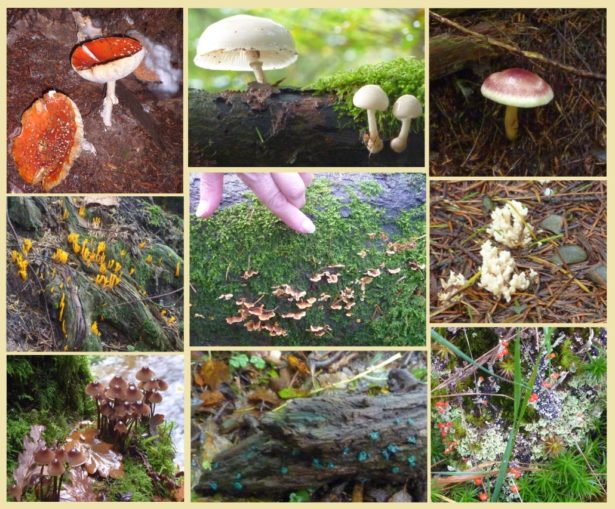
© SharpieType301 2013
The countryside gets wilder still as we approach the river running down from the Cavern Cascade, with many little waterfalls and rocky gorges, each seemingly more wonderful than the last. The drop-offs from the edge of the slippery, uneven path are definitely scary here, and we see a deep fissure in the rock.
No, it isn’t the cavern we’re heading for, most likely an exploratory mining tunnel, but there’s too much water on the floor to try to make our way in to see more and our torches only help a little. Slightly disappointed, we continue, but just around the bend there’s a breathtaking waterfall streaming down the rocks like a lace wedding veil. With the leaves in their autumn reds, yellows and golds, the white water across dark, wet stone, the rusty-browns and deep greens of spiky conifers and the now blue sky above, this is a magical sight.
As we walk further, we begin to hear a low rumbling—sounds like there’s a damn big waterfall ahead. Ah yes, just round a large outcrop of rock… but we can’t see it. The path mysteriously stops ahead! To our right we see a rocky slope and a few rough-hewn steps up to a rock-cut tunnel. My sister and I can’t wait for the men to catch up with us, so up we clamber. That rumbling is much louder now, and there’s a stiff breeze blowing through the cavern towards us. Dragon’s breath, perhaps?
The cavern runs for a short way straight ahead, then turns towards the left near the end. By now we can’t hear each other speak against the roar of the water but, hesitantly, we make our way along the tunnel over the slippery rock floor, becoming more aware of the increasing spray in the air as that sound intensifies. As we cautiously round the bend what’s left of our breath is swept from us by the sight, sound and vibrations of the awe-inspiring cascade pouring past us, just beyond the oval cave aperture, pounding into the roiling pool below, scoured deep by the force of the water. Just standing in the cave is like being under a power-shower—we’re drenched in seconds, deafened, exhilarated, and can barely see. The camera wouldn’t stand a chance here, but if we were to do nothing else for the whole time we’re here, this one moment has been worth the holiday.
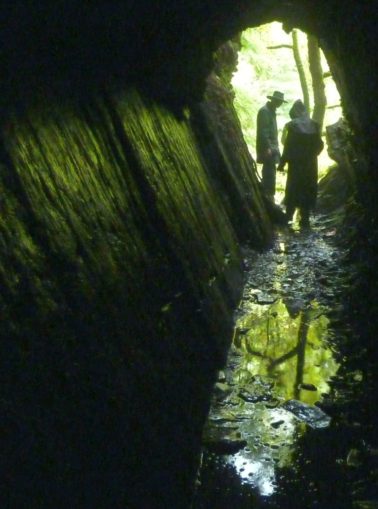
© SharpieType301 2013
We graciously deigned to head back out to give my husband and brother-in-law a chance to see this amazing sight. They too come out, shaking their heads in amazement, and we start to move on—but we can’t resist going back for another look at this jaw-dropping cascade. The rains really have made it the most spectacular sight, and all we could keep saying was ‘wow’! My sister and I speechless? Now that’s really something!
By now, it was getting later in the afternoon and we certainly didn’t want to walk these paths in the dark so, slightly regretfully, started to head for home. We walked back a different way, through gentler land. Beautiful scenery, reminiscent of alpine pastures and quite beautiful in its own way. The sun was just starting to set as we reached the cottage, so we had a sturdy tot of rum with our tea, purely for medicinal purposes of course. Time to get muddy boots cleaned for tomorrow and put aside to dry out, then it’s gammon steak, eggs and mushrooms, and relax with a few quizzes and a bottle of wine to help us along. What a day!
The next day, we had planned to visit Aberystwyth, an ancient market town where the Rivers Ystwyth and Rheidol meet to join the sea. The weather was noticeably cooler, and we drove there in… yet more torrential rain, so hot coffee was a priority before we started to explore. We were lucky, as the rain first slackened, then stopped altogether whilst we were inside. Although it was still blowing a hooley, and not exactly warm, that was fine for a bracing walk along the seafront towards Cliff Railway, a Grade II Listed funicular, to marvel at Victorian engineering.
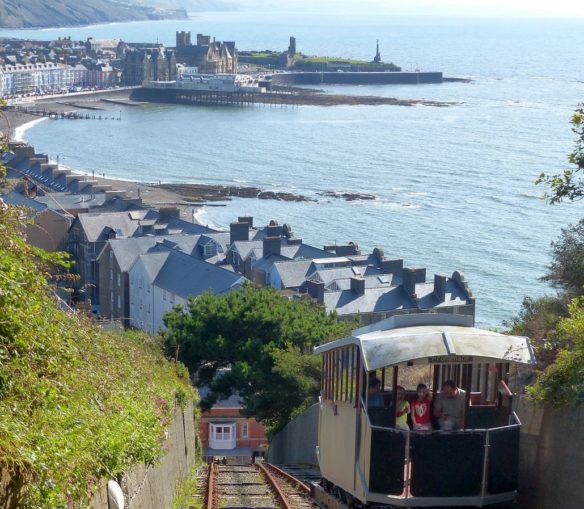
© Robin Drayton, licensed under CC BY-SA 2.0
We decided against going up to the top, and headed back along the promenade in the direction of the castle. We didn’t quite make it that far, as on a set of stone steps down from the prom to the water, just past the pier, we saw an extremely sad sight. A sick cormorant, huddled tight into the corner of a step looking very morose. We popped into the nearest hotel where a kind receptionist looked up the number for the local RSPCA. The lady we spoke to was, for once, grateful for our concern and promised that someone would come out to help the poor thing.
By now it was well into the afternoon and we were a bit chilly, so we decided we would go somewhere for a bite to eat, call it a (very) late lunch. Ah, we were not far from Ultracomida, a very nice deli who specialise in cheeses and meats (mainly from Spain, though not only on the plain). That meant we could also pick up a few treats for the following day’s celebrations.

© SharpieType301 2013
We had it almost to ourselves, and ended up choosing a lovely cheese and meat platter, roast vegetables with cumin, olives and a delicious tuna dish with, of course, a glass of wine each (or in my case, a nice cool, crisp fino). Delicious, and just as we were finishing a lovely Spanish gentleman, possibly the owner, offered us some wines to taste, talking us through the regions they came from, which grapes were used, and which foods they would best pair with. Very pleasant, and we came away with the treats we’d planned to pick up, and sharing a couple of cases of a rather nice Menade Sauvignon Blanc from Rueda and a wonderful Borsao Garnacha from Zaragoza.
We reached the cottage just before it was fully dark (thank goodness, as the need for torches to get down those steps had not been considered!) and settled in for a quiet evening sampling some of our new wine. Late to bed that night, and not quite steady on our feet, my sister and I both found ourselves heading for the loo in the early hours to the ‘to-whit-to-woo’ of the tawny owls hunting in the woods nearby. We couldn’t resist looking out of the window and the skies were clear, so there was no rain. We looked at one another and, as one, out we went in our nighties to stand in the garden to see the glorious night sky, with its plethora of stars glittering against the black velvet. A real delight, even if we didn’t see any owls. The moon had been full a few days before, but was still beautiful, and it wasn’t cold so we were out for some time. Both husbands decided we must be plumb crazy!
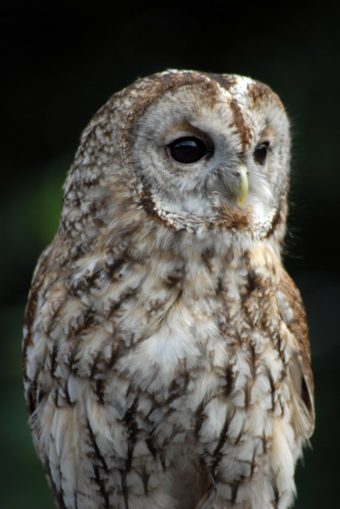
© Chris Paul Photography is licensed under CC BY 2.0
The next day dawned bright, though not exactly early for us, but the heads were surprisingly clear, the birds were singing, the sun was shining and it was celebration time! Both my husband and I were born on the same date (albeit different years), so it seemed natural to get married on that date too. The mist was rising from the river, the sheep were starting to graze across the dewy meadow and all was right with the world, so it was tea and breakfast, before a gentle walk.
We headed for the Bedford Monument (raised by Thomas Johnes in memory of his great friend, Francis Russell, 5th Duke of Bedford, who died at the young age of 36), then on to Mariamne’s Garden. This was designed and planted as a private retreat and botanical space for Thomas Johnes’ 12 year old daughter, Mariamne, by his friend the Scottish agriculturalist Dr Robert Anderson in 1796. Originally a small, walled, secret flower garden, it contained a moss house and showcased shrubs and alpine plants. Although none of the original plantings survived, the space has been cleared and re-planting the interior with authentic flora is under consideration. A peaceful spot, which was the perfect place to sit and soak up the warmth of the sun for a while.
We wandered up towards Hafod Church, dedicated to St. Michael and All Angels. Not the first church, built in 1620 by Morgan Herbert, but the more elegant church commissioned by Thomas Johnes in 1803 to replace it. Although damaged by a major fire in the 1930s, it was beautifully restored and is a warm and tranquil place, with a spectacular yew in the churchyard.
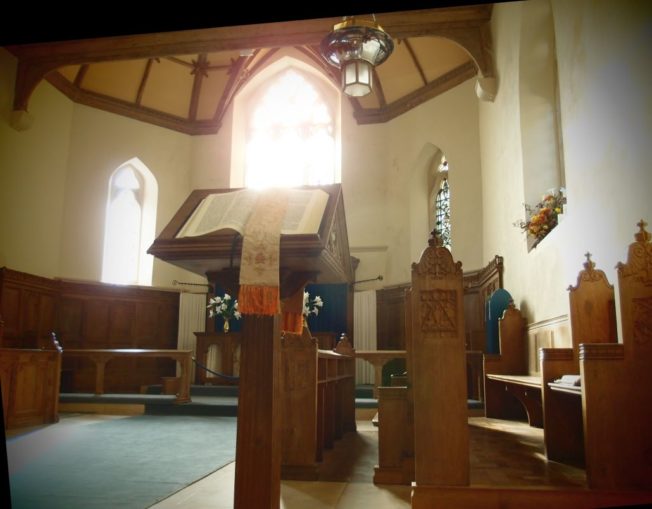
© SharpieType301 2013
As we left the churchyard, intending to continue our walk, the clouds had begun to gather and the sky was looking very black. We were ready for a cuppa too, and realised it was nearly 3 o’clock, time to head back for cards and presents. As usual, it didn’t quite happen as planned. By the time we got to the cottage the clouds had blown past in the strengthening wind with only a few spots of rain, so my sister and I left the men dozing and headed off on our own to explore. We couldn’t bear to waste what remained of the sunshine.
We explored the pond, just outside the cottage, then followed narrow sheep paths up along the edge of the hillside where thick cushions of moss blanketed fallen tree stumps and branches. Not easy going, so we dropped down to the meadow, heading from beech tree to beech tree as the slope was so steep. We watched red kites wheeling high above us, played pooh-sticks from the Alpine Bridge and, on our way back towards the cottage, discovered the remains of the elusive Ice House.
With its corbelled roof and deep, circular pit, it sat tucked almost out of sight in a sheltered spot, nearly entirely underground so only the entrance was visible. In the heyday of the Estate, well before the ease of modern refrigeration, ice would be cut from the river in winter and tightly packed in insulation (usually straw) to stay frozen for use through the summer.
By now the light was fading and the wind was really picking up. We were entranced by the streams of coloured leaves being whisked from the trees to dance in the air as we headed for home where, back together with the husbands, those presents and cards were finally opened. What a magical birthday and anniversary!
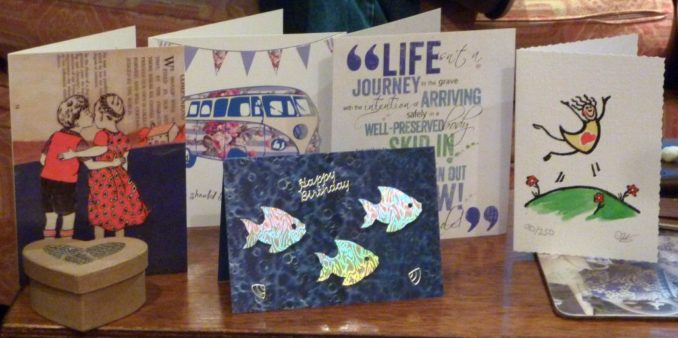
© SharpieType301 2013
We’d had a fairly energetic few days, and were glad to tucked up indoors, relaxing away from the darkness and wildening weather. No rain yet, but it’s heading our way and it feels like there’s quite a stormy night ahead. Dinner that night was to be a lengthy and sumptuous affair, a proper celebration, with chicken in a creamy mustard sauce already simmering away in the oven, filling the cottage with mouthwatering smells. We’d eat well again that night and of course that chook would be served with all the trimmings, suitable beverages amongst them, but we’d start with some of the treats we’d picked up in Aber the previous day. As we enjoyed our birthday meal, and sat back with a whisky afterwards, the rain duly arrived.
By the morning, and our last full day, the rain was not torrential, but persistent and the wind seemed to die back too so the grey skies and heavy drizzly rain is probably in for the day. Not really a day for the Hafod walks, so we decide to head for Borth, where none of us has ever been. There’s ancient petrified forest there apparently, visible at low tide along the beach. Dating to around 1,500 BC, it’s associated with the legend of Cantre’r Gwaelod, the Welsh Atlantis, and sounds very romantic.
In reality, as we drove in, this once thriving fishing port looked dire—quite run down and neglected rather than the quaint town we’d been expecting. Never mind, there’s a sign to a nature reserve so we head on through, leaving the town behind, to get there. Good choice, it is past Ynyslas where the estuary of the River Dyfi meets the sea, looking across to Aberdyfi, and it’s lovely.

© SharpieType301 2013
We walk along clean, flat sands, sheltered by dunes complete with Marram Grass. There are thousands of shells, a beautiful mountain backdrop, and the gentle plash of the waves, accompanied by the sound of the bells from over the estuary—the bells in the tower of St Peter’s Church play ‘The Bells of Aberdovey’. A strong wind which was sculpting the sand in ‘V’ shaped ripples, which drifted slowly sideways as we watched, fascinating us all. There are some old pieces of wreckage scattered across the sands too, decayed and rusted into pieces of art by the wind, waves and time. Gulls, cormorants, oystercatchers and other sea birds, but precious few people. Our own private paradise, for a while at least.
We decided to go back into Aberystwyth and have another late lunch at Ultracomida (yes, it really was that good), so we make our way there and are not disappointed. Once again, we pick up a few bits and pieces, this time to save us cooking on our last night at Hafod. My husband sneaked away to get some cockles and dressed crab for an extra treat too. Easy on the wine tonight mind, as we need to be up and out early tomorrow. Back to the cottage and we pack our bags and take whatever we can up to the car to save time in the morning, then settle down to our final feast.
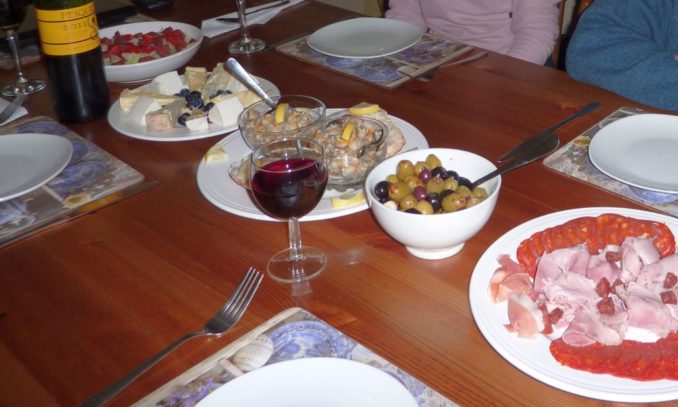
© SharpieType301 2013
Tomorrow, we’ll go our separate ways, my sister and brother-in-law heading for the South East, and us to Moelfre to collect our finished Jesmonite sculpture of our linked hands.
To be continued…
© SharpieType301 2020
The Goodnight Vienna Audio file
Audio Player



